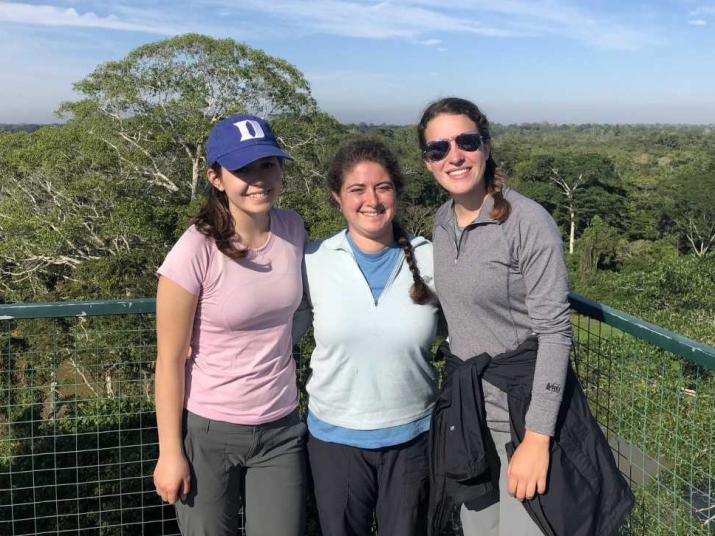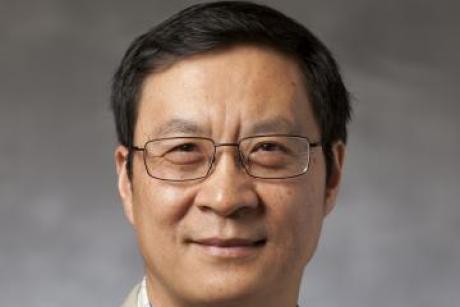
Undergrads Melissa Marchese (left) and Kelsey Lansdale (right) and global health doctoral scholar Jackie Gerson (center).
Published July 25, 2018 under Voices of DGHI
By Kelsey Lansdale ’19 and Melissa Marchese ’21
Hi, we are the 2018-2019 Environmental Epidemiology in Latin America Bass Connections team studying the impacts of artisanal gold mining in the Peruvian Amazon. Our group is comprised of Professor Emily Bernhardt, Ecology Ph.D. candidate (and global health doctoral scholar) Jacqueline Gerson and undergraduates Kelsey Lansdale and Melissa Marchese.
The three students on our team are currently moving up and down the Madre de Dios River in the Peruvian Amazon collecting samples and doing research. This tropical, biodiverse region is a frontier of natural resources. As a result, this area is a hotspot for precious metal mining, with gold mining booming in the last few decades from increased demand and new extraction methods.
Mercury contamination from this largely illegal goldmining has caused issues in Peru for hundreds of years and become the biggest global source of mercury pollution. The area is currently facing many consequences from this, which we hope to understand and help mitigate through our work.
The main objective of our project is to understand how mercury travels through the ecosystem. While here, we are collecting wet deposition, dry deposition, soil samples, water samples, tree cores, crops and air samples in five sites either upstream or downstream from the epicenter of mining, near a city called Boca Colorado.
We will be in Peru conducting field work until late August and are excited to share some of our stories.

We start our approximately 10-hour journey from Cusco to Atalaya in Plaza San Blas on a crisp Peruvian winter morning. We await our driver, standing on a corner of the square with a mountain of gear and supplies (including five coolers, four large duffels and our hiking backpacks between the three of us), awkwardly watching a first communion procession occurring in the square surrounding us.
After receiving 55 PVC setups specially designed for rain collection, we load an 11-passenger van with our driver, Jesús, and begin our trip. Not even 10 minutes later, we get a flat tire on a narrow one-way street of Cuzco and stop in an industrial area of the city to fix it. About four hours later than we planned, we are on our way.
We make our way through dry, dusty mountain roads and stop in a small town for lunch about halfway to Atalaya where Jesús briefly meets with his wife who lives there. Somewhere along the way, the mountains and valleys turn into a dense cloud forest. In the evening, we are met with kindness and food by Cecilio, the owner of our boat company, his wife and the family at whose house/restaurant/food store we spend the night.
The next morning is gray and rainy as we organize our stuff, load the boat and set off for Boca Manu. We collect a few water samples along the way, scout the area and get a feel for water levels and tree cover at some potential sites. We are hoping for something accessible by boat with specific foliage criteria to yield the most representative results.
After several hours, we arrive in Boca Manu, greeted by chickens and the residual festivities from the district’s independence party the night before. We are given a room to stay in, but there’s a random man sleeping in it, so we are moved. We are served delicious meals in one of the town’s few restaurants.
In the morning, after our wake-up call from the resident livestock, we eat breakfast and head down the river. Our boat drivers, Ramiro and Francisco, are incredibly experienced and informative and somehow know every curve, tributary and station along the unmapped river. They know every rio (river) and pueblo (town) we ask about as we wind through the monte (rainforest). We stop at birding lodges, observation stations and other conservation areas scouting a site to set up the PVC rain collection tubes.

Finding an acceptable site is not an easy task. We need somewhere with a lot of tree cover consisting of vegetation common to the area and a nearby space devoid of tree coverage. This allows us to get clean samples of rainfall and see how foliage affects the mercury content in the water.
We stroll along trails, both established and created by Ramiro’s machete, and Francisco and Ramiro point out species along the way. They know many of the trees here, giving us their uses along with the local names.
“That one’s sap is good for stomach problems,” Ramiro says as he points to an Oje tree, “but have more than a spoonful and it will poison you.” Some are for logging, some house harpy eagles and some produce fruits. They know so much about the land because it has been invaluable to them, providing both food and income in the form of tourism jobs in Manu. They love this land and join us and many researchers before us in the fight to maintain its health for both the ecosystem and the people that live in it.

During our first week, we set up five sites for wet deposition (rainfall) collection along the river both upstream and downstream from the primary mining area. These include: one far upstream at the River Manu, one at the River Chileve halfway between the first and third setups, one at an abandoned mining camp near Boca Colorado (one of the primary mining towns), one slightly downstream at a Biological Research Station called Los Amigos and one farther downstream in Laberinto.
As we move down the river, we start seeing mound after mound of rocks and sediment. It looks like a small coastal mountain range. This is the aftermath of extracting gold from the river.

The coast is lined with makeshift barges, which can suck up and sort large amounts of sediment from the river bottom. According to Ramiro, the miners can extract 20 or 30 grams of gold per day from these setups and up to a kilo with some of the heavy machinery we see along the beach.
We see small cities of washboard-looking setups called gravity concentrations, which separate the heavy soil containing the gold from the rest. Surrounding, there are also oil drums in which the miners mix the heavy soil with elemental mercury and stomp in to form an amalgam – a clump of mercury and gold which allows them to isolate the precious metal from the tons of soil. That amalgam, mercury and all, is then burned to leave behind only pure, shiny gold.
The issue with this is that the mercury vapor proceeds to travel into the environment and makes its way into air, water, soil, plants, animals and human beings. The elemental mercury, if not breathed in directly to accumulate in the body, can become methylated under anaerobic conditions. It transforms into a toxic organic form and presents in the environment in many ways, the trends of which are our primary focus.
We make our way along the river and the once-sporadic gold mining setups become more frequent. Soon you can’t travel for more than five minutes without seeing them.
On our long trips on the boat where we see both the awesome natural beauty of the Amazon and the grimy makeshift mining setups, we often pass the time with fun conversations like discussing our ideal superpowers. The three of us decided on invisibility, the ability to speak all languages and a photographic memory. We turn to Ramiro and ask him the same question. He responds that he would make all of the gold mining stop.
After hearing Ramiro’s seemingly achievable “superpower” versus our unrealistic ones, we begin to realize how important the research we are conducting could be in the fight to end illegal gold mining. If our team is able to spread our findings and enact policy change, we could help to make what Ramiro believes an impossible vision for a better future for his beloved monte into a reality.
Learn More
- Read more about how this team has worked to build community trust in the Peruvian Amazon.
- Check out this video on how the team uncovered a public health crisis in Peru.

